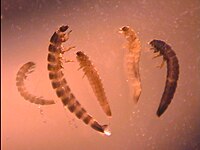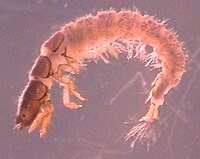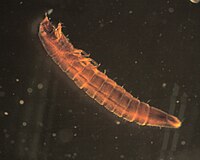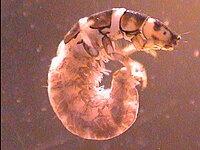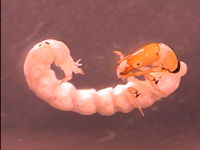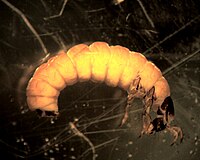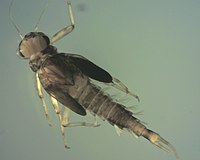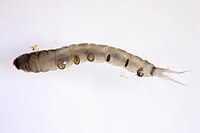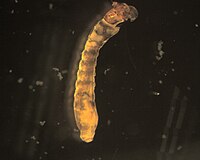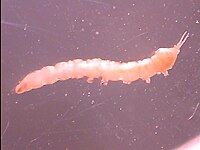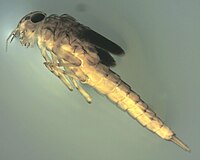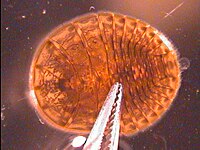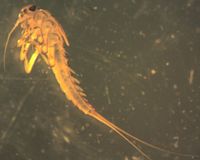Vermont EPSCoR's Streams Project; A Teacher Collaboration on WikiEducator
Openly shared content, practices, and developing resources from Vermont EPSCoR's Streams Project. Join this collaboration and make a difference!
 Allen Brook VT |
|---|
|
| Stream code: | WR_AllnBrk_361 |
| Basin: | Winooski |
| State or Province: | Vermont |
| Country: | USA |
| Latitude: | 44.451226 |
| Longitude: | -73.102601 |
| School: | Saint Michael's College |
The following are the most common invertebrates collected from this stream site.
Chironomidae
- Order
- Diptera
- Family
- Chironomidae
- Common name
- Nonbiting midge
- Tied fly
- Griffith's Gnat
Midge larvae tend to be the most common macroinvertebrate at our sites. As with other Diptera, there are no true jointed legs. Chironomidae do have a pair of prolegs at each end and preserved individuals tend to curl into a 'C'. Identification past family requires slide-mounted heads. We have seen philopotamid caddisflies misidentified with the chironomids and we suspect that that happens when samples are being sorted from trays. Under a microscope, six prominent legs can be seen on members of the caddisfly family Philopotamidae.
More information on Philopotamidae.
Pisidiidae
- Order
- Veneroida
- Family
- Pisidiidae
Fingernail clams are the most common small clams that we find in Vermont rivers. Larger bivalves should not be sampled because they may belong to a protected species. Under no circumstances should clams be moved from one river site to another.
Elmidae
- Order
- Coleoptera
- Family
- Elmidae
- Common name
- riffle beetle
We very commonly find adult and larval riffle beetles. The adults are clearly beetles, but the larvae can be confused with other orders. The forward pointing tooth on the front end of the larvae as described in the key can be a challenge to see, particularly in small individuals. Larvae are characterized by having a single tarsal claw at the end of their legs, which have 4 segments. Adults, on the other hand, have two tarsal claws at the end of each leg. Commonly encountered genera include
Dubiraphia,
Macroychu,
Optioservus,
Phanocerus,
Promoresia, and
Stenelmis.
Images of the adult and larval riffle beetles.
More information on Dubiraphia, Macronychus, Optioservus, Phanocerus, Promoresia, and Stenelmis.
Cheumatopsyche
- Order
- Trichoptera
- Family
- Hydropsychidae
- Genus
- Cheumatopsyche
Cheumatopsyche has a
forked foretrochantin (as does
Ceratopsyche). The foretrochantin is the projection at the uppermost portion of the front leg closest to the head. The leg may need to be pulled away from the body to expose this feature.
Cheumatopsyche have a small or inconspicuous
pair of sclerites under the prosternal plate that are difficult to see. Contrast that with the
larger pair of sclerites found on Ceratopsyche. To access sclerites, it's best to gently pull the pronotum and mesonotum in opposite directions. Note: the large single sclerite is the prosternal plate.
Cheumatopsyche have only 2 types of
hair on the abdomen: long thin plain hairs and thicker club hairs, which are narrow close to the body and widen out at the distal end. Paired sclerites on the ninth abdominal segment are notched.
Stenelmis
- Order
- Coleoptera
- Family
- Elmidae
- Genus
- Stenelmis
The larvae of
Stenelmis, as in
Ordobrevia, have a sternum on the ventral side of the pronotum. The main difference between the two genera is in the antennae the second segment is less than twice as long as the first in
Stenelmis.
The adult Stenelmis has a clear separation between the thorax and abdomen as well as a more distinctly separate head as compared to other genera.
Click here to see pictures of the sternum and
antennae-
Ceratopsyche
- Order
- Trichoptera
- Family
- Hydropsychidae
- Genus
- Ceratopsyche
Ceratopsyche has a
forked foretrochantin. The foretrochantin is the projection at the uppermost portion of the foreleg. The leg may need to be pulled away from the body to expose this feature.
Ceratopsyche have a
large pair of sclerites underneath the prosternum. Note: the large single sclerite is the prosternal plate. Biologists have gone back and forth between lumping this genus into
Hydropsyche and splitting it back out. ITIS currently lists it as a genus (Feb 2013) but we are aware of a recent paper that lumped it under
Hydropsyche.
Hydropsyche
- Order
- Trichoptera
- Family
- Hydropsychidae
- Genus
- Hydropsyche
- Common name
- spotted caddis
- Tied fly
- dark cahill
Hydropsyche are net-spinning caddisflies and share most characteristics with other members of the Hydropsychidae, including the
Ceratopsyche.
Hydropsyche are distinguished from
Ceratopsyche by the presence of scale hairs and minute spines on the three most posterior abdominal segments.
More information on the Ceratopsyche can be found here.
Image of the sclerites in the intersegmental folds.
Chimarra
- Order
- Trichoptera
- Family
- Philopotamidae
- Genus
- Chimarra
Chimarra are distinguished from the other Philopotamidae by a prominent asymmetrical notch in the frontoclypeus as well as a prominent process on the femur which bears a single hair (seta).
Images of the asymmetrical notch and prominent process.
Glossosomatidae
- Order
- Trichoptera
- Family
- Glossosomatidae
- Common name
- saddlecase caddisfly
Larvae in this family build domed cases made of small rocks, and are often wider at segment 5. The pronotum is covered in dark, sclerotized plates, but there are either
no sclerites on the mesonotum, or the mesonotum is unsclerotized with the exception of a few patches. The anal proleg is broadly joined to segment 9; the anal claw has one or more accessory hooks. The
pronotal excision is small (approximately 1/3 anterolaterally) to accommodate the coxae.
Commonly encountered genera include Glossosoma and Agapetus.
Acerpenna
- Order
- Ephemeroptera
- Family
- Baetidae
- Genus
- Acerpenna
- Common name
- Tiny blue-winged olive
This genus is can be identified by the costal process, or projection, distal to the hind wing pad. Gill 7 is slender and may be pointed at the end. The antennal scape and pedicel have a few scattered setae (hairs).
Image of the antennal scape. A ventral view can be seen here.
Antocha
- Order
- Diptera
- Family
- Tipulidae
- Genus
- Antocha
This small dipteran in the cranefly family is quite common. It is distinguished from most other dipterans we found by the 'creeping welts' that appear as prominent dark stripes along the abdomen. The dark head is usually partly exposed; however, it can be pulled back into the thoracic cavity during preservation.
Simuliidae
- Order
- Diptera
- Family
- Simuliidae
Simuliidae appear rather like bowling pins with heads. Relatively speaking, we collect few members of this family and have we have not identified them past family at this point.
Click here for a close up image of the heads.
Dicranota
- Order
- Diptera
- Family
- Tipulidae
- Genus
- dicranota
Dicranota can be distinguished by the two tails and their comb feet. There are usually 5 pairs of prolegs on the abdomen with combs on them. In addition, the posterior portion of the abdomen often has a slight swelling.
Image of the prolegs.
Pseudocloeon
- Order
- Ephemeroptera
- Family
- Baetidae
- Genus
- Pseudocloeon
- Tied fly
- Bluewinged Olive
Mayflies in this genus have a distal lobe on their antennal scapes, and the second segment of labial palps has an expanded medial process. Villopores are absent on legs.
Click to see the antennal scapes. The dorsal and ventral views can be seen here.
Psephenus
- Order
- Coleoptera
- Family
- Psephenidae
- Genus
- Psephenus
The true "water penny" is commonly found in the waters sampled.
Psephenus has a rounded shape with relatively smooth edge. The
false water penny, whose edges are serrated, has a more oval appearance. The
gills on the ventral surface are found only in the true water pennies.
Another genus encountered in this family is Ectopria.
Baetis
- Order
- Ephemeroptera
- Family
- Baetidae
- Genus
- Baetis
- Common name
- The Little Olive
- Tied fly
- Sawyer Pheasant Tail Nymph
This mayfly has three "tails" and a unique head shape. Its gills are oval shaped and insert dorsally. More mature nymphs have long, dark wing pads.
Image of the long, dark wing pads.



